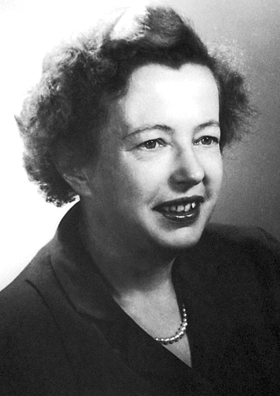Biography
Maria Goeppert was born on June 28, 1906 in Katowice, Germany. She was the only daughter of Friedrich Goeppert and Maria, née Wolff. When she turned four, her family moved to Göttingen, where Friedrich became a professor in paediatrics. Maria's father encouraged and supported her studies. During her childhood and adolescence she was surrounded by great researchers in mathematics and physics. David Hilbert himself was her neighbour and a close friend of the family, as well as Max Born and James Franck. Maria soon felt drawn to mathematics and planned to study at university. She chose Göttingen, which seemed perfect because its mathematics and physics departments were highly prestigious. However, there was not any public institution that educated girls to that purpose, and so she joined a private school that prepared girls for university in 1921. The school closed due to lack of funding, but that did not stop Maria from taking the access exam in 1924 and enrolling in the University of Göttingen to study mathematics. That same year, the theory physicist Max Born invited her to join his physics seminar. As a result, she decided to change mathematics for physics. At the time, Göttingen was one of the main developing centres of quantum mechanics, and it was hard not to fall for that intellectual challenge. There were three future Nobel laureates among her professors: Max Born, James Franck and Adolf Otto Reinhold Windaus. Later, Born would become her mentor and her thesis director.
Maria earned a doctorate in physics in 1930. In her thesis, she calculated the probability of a that an electron orbiting the nucleus of an atom would emit two photons of light when jumping to an orbit closer to the nucleus. Her solution was confirmed decades later, in 1960, using lasers. Years later, Eugene Wigner caller her thesis "a masterpiece in clarity and succinctness".
After finishing her thesis, she married Joseph Mayer, a young man from the United States who was a post-graduate student at Göttingen. The couple moved to the United States, where Joseph had obtained a chemistry associate professor post at Johns Hopkins University.
At that university (1931-1939), as it would later happen in Columbia (1940-1946) and in Chicago, universities in which her husband worked, Maria Goeppert Mayer was allowed to work as a voluntary researcher, but with no pay. It was mostly because of sexism, but also because of the strict rules against nepotism which did not allow to hire family members of professors at universities. During this period, she published numerous papers and wrote, alongside her husband, a book on statistic mechanics.
In fact, despite her worth and capabilities, she spent most of her career as a volunteer, unpaid professor and researcher. She did not get a full-time paid job until she was 54.
However, she was able to develop some brilliant research work and to find other job opportunities, including a job as a teacher in the Sarah Lawrence College.
She also managed to collaborate, during World War II, in the Manhattan Project to develop the atomic bomb, albeit in a secondary line of research.
It was after the war, in her period in Chicago and Argonne, that she developed a mathematical model for the nuclear shell.
Her research led her to establish the nuclear level theory, which states that the nucleus of the atom is made up of layers. The more saturation there is in the layers, the more stable the nucleus, and thus the element, will be. Those nuclei with 2, 8, 20, 28, 28, 50, 82, or 126 protons or neutrons were particularly stable. These numbers were called "magic numbers", but she was not satisfied with that. Now that she knew they were special numbers, she wanted to know why. Maria made them no longer magic, because she developed the spin-orbit theory of the nucleus. That is, she applied the same theory to nucleons as to electrons.
In 1956, she was appointed member of the National Academy of Science in the United States.
In 1960, Maria Goeppert Mayer was offered a full-time job as a professor of physics at the University of California, in San Diego. It was the first recognised, paid job that she got. She was 54 years old at the time.
In 1963 she was awarded the Nobel Prize in Physics for her discoveries related to nuclear layered structure, shared with the German researchers J. Hans D. Jensen and Eugene Paul Wigner. The German scientists that she shared the prize with worked the exact same theory in parallel. In her acceptance speech, Maria Goeppert Mayer said: "Winning this prize has been half as exciting as doing my job".
Despite suffering from a stroke short after getting a job at the University in San Diego, she continued teaching and doing research for many years. She died of a heart attack on February 20, 1972.
Extracted from Rincón educativo, foro de la industria nuclear española https://www.rinconeducativo.org/es/tags/maria-goeppert-mayer (11/04/2011).
Extracted from Wikipedia https://es.wikipedia.org/wiki/Maria_Goeppert-Mayer (11/04/2011).
